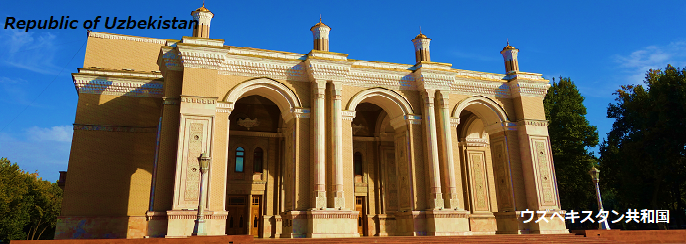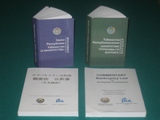Uzbekistan

Activities and Results
Since 2008, the ICD has annually organized a region-focused training course, the “Comparative Study Seminar on the Legal Systems in Central Asia,” under the theme of corporate legal systems in Central Asian countries, inviting relevant officials from Kazakhstan, Kyrgyzstan, Tajikistan and Uzbekistan.
With regard to Uzbekistan specifically, JICA, with the cooperation of legal researchers and other experts, engaged in legal support projects to improve administrative procedures and other aspects of the system with the goal of stimulating corporate activity and activating the private sector. These projects lasted for a total of five years, from 2005-2008 and 2010-2012.
Although the project was concluded in 2012, legal and administrative reforms to improve transparency in administrative procedures were continued in Uzbekistan. This led to the establishment of the administrative courts in 2017 in addition to the creation and successful adoption of the Administrative Procedures Act and the Administrative Litigation Act in January 2018. Uzbekistan is designated as a priority country under the Basic Policy on Legal Technical Assistance (Revised edition) and has great expectations for the Japanese assistance provided to its legal system.
In March 2018, the International Cooperation Department invited judges and prosecutors from Uzbekistan to a joint research seminar to discuss the contents and potential application issues of the new Administrative Procedures Act and Administrative Litigation Act. By cooperating on these issues, the International Cooperation Department is dedicated to strengthening cooperative relations moving forward while establishing friendly relationships in the legal field.
In 2019, in order to strengthen the relationship with Uzbekistan, two Memorandum of Cooperations (MOCs) were signed: one in March between the Ministry of Justice of Japan and Uzbekistan and the other in July between the Research and Training Institute, Ministry of Justice of Japan and the Academy of General Prosecutor’s Office of Uzbekistan.
Based on the MOCs, further development of cooperative relationship in the legal field between the two countries is expected, responding to Uzbekistan’s high expectation toward Japan’s legal technical assistance.
The Project for Drafting the Commentary on the Bankruptcy Law of the Republic of Uzbekistan

After receiving a request for assistance from the Uzbekistan Supreme Economic Court, the International Cooperation Department, in cooperation with related entities such as JICA as well as Japanese bankruptcy law experts, began assistance for drafting of the Commentary on Bankruptcy Law in 2004. In March 2007, the Russian version of the commentary was published, followed by the Uzbek and Japanese versions later that year in September. The English version was published the following year in March 2008.
In addition, JICA and the Uzbekistan Supreme Economic Court possess the copyright to the Russian, Uzbek, Japanese, and English versions of the commentary.
[Part 1: Events leading to the beginning of the project]
Following the collapse of the Soviet Union, Uzbekistan gained its independence in 1991 and began its transition to a market economy.
In order to support Uzbekistan’s transition to a market economy, the Research and Training Institute of the Ministry of Justice, with the cooperation of JICA, began offering training in Japan for Uzbek legal experts in 2002 focused on the theme of “legal systems that support economic activity” as part of its ODA operations.
Incidentally, because only state-run businesses existed during the Soviet era, there was no bankruptcy law in place as the general notion of private enterprise or corporate entities going bankrupt was foreign at the time.
However, after gaining independence from the Soviet Union, formerly state-run businesses underwent privatization as part of the transition to a market economy. Corporate bankruptcy became a necessity, and the Bankruptcy Law of the Republic of Uzbekistan was enacted in 1994.
As a result of the comparatively recent enactment of bankruptcy law in the country, inconsistent handling of bankruptcy procedures, handling of procedures inconsistent with the text of the law, inability to select the appropriate bankruptcy proceedings, and other issues arose.
One of the reasons for the issues was the lack of a legal precedent for officials to reference in bankruptcy cases. This led the Uzbekistan Supreme Economic Court, which had jurisdiction over bankruptcy in the country, to request assistance from Japan in producing literature regarding the bankruptcy law.
The Research and Training Institute of the Ministry of Justice, together with JICA, consulted with the Uzbek government on what kind of literature to produce before deciding to support the creation of a commentary on the bankruptcy law.
This was how The Project for Drafting the Commentary on the Bankruptcy Law of the Republic of Uzbekistan (August 2005 – July 2007) began.

For this project, it was determined that it would be a joint effort between Japan and Uzbekistan: working groups will be formed, and the Uzbek side will produce commentary drafts after which the Japanese side will annotate them and provide comments. The Uzbek side will then revise the draft based on the comments and the process will repeat itself until a satisfactory conclusion is reached.
Members of the Uzbek side consisted of Economic Court judges handling bankruptcy cases and officials of state agencies responsible for bankruptcy cases (national committees supporting corporate activity, competition, and antitrust projects) in charge of executing bankruptcy proceedings in line with the bankruptcy law.
Members of the Japanese side consisted of legal researchers and lawyers specializing in bankruptcy law as well as experts in Russian law.
Additionally, the Japanese side dispatched a lawyer to Uzbekistan as JICA’s long-term expert who offered guidance on the commentary and local support for its implementation after its publication.
Over the course of the two-year project, the Japanese and Uzbek teams held eight conferences in Japan and four conferences in Uzbekistan for a total of twelve direct meetings discussing the content of the commentary drafts from October 2004 to November 2006.
There was a direct meeting held once every approximately two months, in either Uzbekistan or Japan, between working groups on both sides.
The publication of the Commentary on the Bankruptcy Law of the Republic of Uzbekistan began with the completion of the Russian version in March 2007. The Uzbek and Japanese versions (September 2007) as well as the English version (March 2008) followed soon after.
Copies of the commentary on the bankruptcy law were provided to experts working on bankruptcy cases and educational institutions in Uzbekistan and the surrounding countries for free with Japanese financial support.
Furthermore, electronic copies of the commentary on the bankruptcy law were made available for download on related state agency websites.
As explained previously in Part 2, it was determined that Japan would provide assistance by offering comments on drafts produced by the Uzbek side which would proceed with revisions of the drafts based on those comments.
However, upon reading the initial drafts provided by the Uzbek side, many elements thought to be necessary in a legal commentary of this nature such as the legislative intent behind each provision were not present. There were also many examples of necessary explanations of provisions being provided in other unrelated or inappropriate provisions.
As discussions proceeded, it became evident that what the Japanese side thought a commentary was supposed to be and what the Uzbek side thought it was supposed to be were two different things.
The Uzbek side’s idea of a commentary consisted of the commentary authors offering appropriate solutions to current issues affecting the actual execution of bankruptcy law provisions with the goal of creating consistency in bankruptcy proceedings. It was to be a manual so to speak. In addition, provisions of the law not currently causing issues or interfering with its implementation did not necessitate explanations nor warrant inclusion in the document.
Conversely, the Japanese side saw the role of a commentary as clearly providing interpretations, explanations, and the underlying philosophy for problematic areas. This framed their commentary of the drafts provided to them by the Uzbek side.
Given these issues present with initial drafts, commentary provided by the Japanese team was wide-ranging covering a variety of topics from formatting issues such as the arrangement order of items to content issues such as the missing provision interpretations and legislative intent, as well as revision of contradicting explanations.
The Japanese team prepared for their comments by thoroughly studying Uzbekistan’s bankruptcy law, related Uzbek economic procedural laws, and commentary and provisions of Russian bankruptcy law.
They also offered various suggestions regarding the structure of the commentary.
For example, because this was to be Uzbekistan’s first official legal commentary on its bankruptcy law, the Japanese side proposed they provide diagrams for explanations and procedures in each chapter of the commentary so educational institutions could utilize the document as an academic text. This proposal can be seen now in the final draft of the document.
Such an initiative has never been undertaken in Uzbekistan, and it seems to have been a worthy endeavor.
This project was implemented through the combined effort of the Japanese and Uzbek sides. The Japanese side offered various suggestions and solutions based on their thorough preparation, and the Uzbek side has incorporated many of those proposals into the finished product.
By working together on the project, the Japanese team was able to provide Uzbekistan with the knowhow for publishing legal commentaries and techniques for interpreting provisions.
It is our hope that Uzbekistan uses the knowledge gained as a reference for future commentary publications.
In addition, current legislative issues regarding the Bankruptcy Law of the Republic of Uzbekistan were made clear through the conferences between the two teams. It is also our hope that these issues will be addressed in the future.
[Part 4: Implementation of the commentary and publication of the English version]
The aforementioned series of events led to the successful publication of the Commentary on the Bankruptcy Law of the Republic of Uzbekistan, but authoring and publishing a commentary does not necessarily solve the issues Uzbekistan currently faces in implementing bankruptcy proceedings. Uzbekistan must utilize the commentary and initiate measures to improve these procedures.
In order to assist Uzbekistan with solving issues in bankruptcy proceedings, this project also began dissemination activities of the commentary.
Throughout these activities, it was found that the existence of the Bankruptcy Law itself was not known to the public in Uzbekistan.
However, if neither creditors nor debtors are aware of the bankruptcy law or the bankruptcy system, this could lead to inappropriate liquidation proceedings in cases of corporate insolvency. Also, businesses with the opportunity to restructure given the right measures will lose that chance.
This project used the publication of the commentary on the bankruptcy law as an opportunity to widely spread awareness of the bankruptcy law and bankruptcy system. It is also why efforts were made to provide the commentary for free to educational institutions and libraries in addition to creating an electronic version available online.
In addition, the publication of the commentary on the bankruptcy law was advertised in every region of Uzbekistan and seminars to deepen understanding of the bankruptcy system were held to promote the use of the commentary.
Although the project officially ended in September 2007, we hope the commentary will continue to contribute to improvements in bankruptcy proceedings in Uzbekistan in the future.
-

Completed commentary -
With Uzbek members

